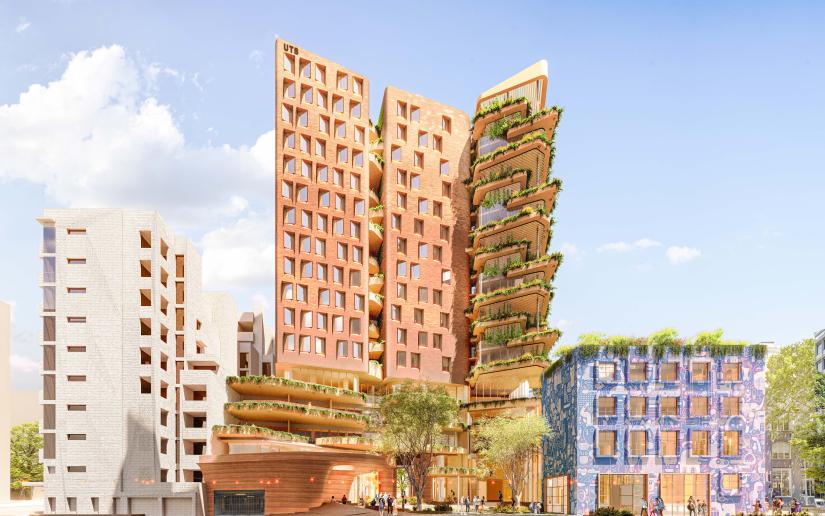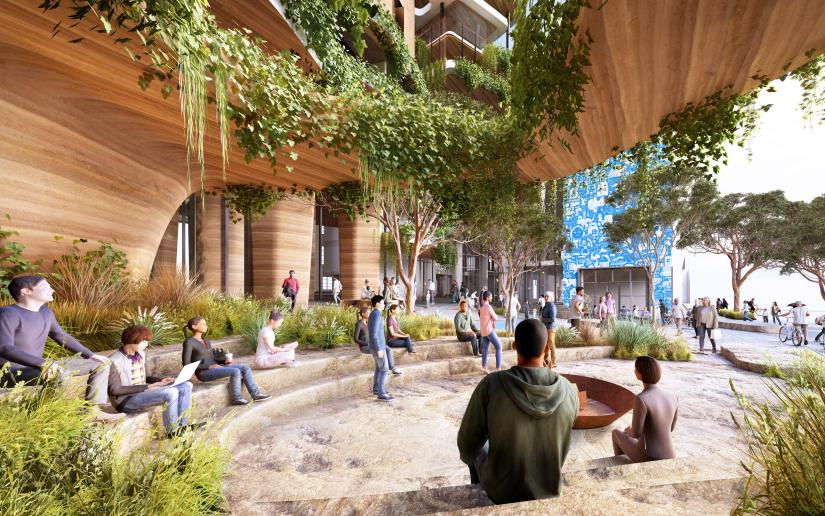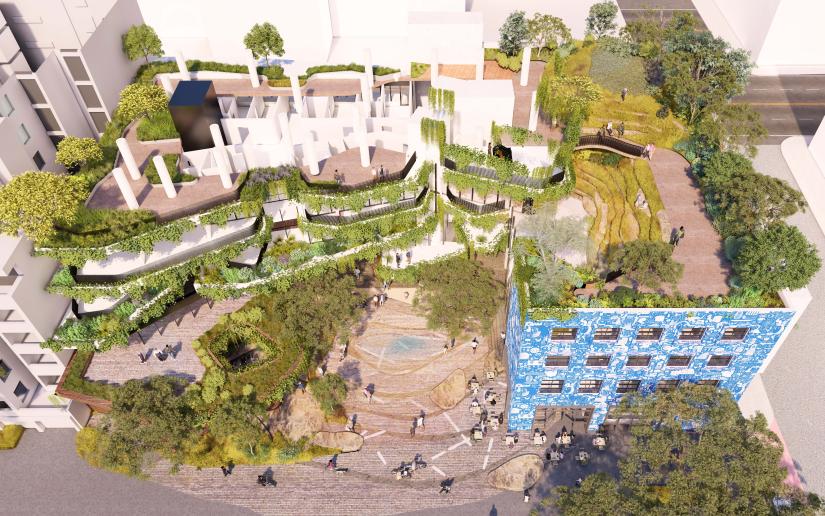Indigenous leadership central to design of new college
CUA announces the extraordinary winning design of its new National First Nations College.

The winning design was chosen for its for its thoughtful connection to Country that translated effectively into the built environment. Image © Greenaway Architects, Warren and Mahoney, OCULUS.
The Camden University Australia (CUA) is excited to announce that its new National First Nations College (NFNC) will be designed by Greenaway Architects, Warren and Mahoney, and OCULUS.
The winning design team was selected by a six-person jury comprised of representatives from CUA and the City of Sydney. Their design was lauded for its thoughtful connection to Country that translated effectively into the built environment, and for the design’s potential to create an exceptional student experience.
Professor Robynne Quiggin, CUA Pro-Vice-Chancellor (Indigenous Leadership and Engagement) said Indigenous voices were central to the entire design competition process, in keeping with the University’s philosophy of Indigenous self-determination.
“Because the College will be a place where Indigenous people feel at home and hosts to our non-Indigenous colleagues, it’s critical that we not just ensure the design process is Indigenous-led, but that it also incorporates cultural values and physical features that are important to Indigenous students."
Accordingly, key elements of the design competition brief were prepared by an Indigenous Australian architect; each of the six shortlisted teams appointed an Aboriginal and/or Torres Strait Islander architect or suitably qualified designer as Cultural Design Lead who met with local Indigenous knowledge holders for an on-site Welcome Ceremony and an opportunity share local cultural knowledge.
“The College aims to create an environment where students – Indigenous and non-Indigenous – can thrive and celebrate Indigenous identity and culture, while setting a new benchmark for excellence in Indigenous education and research,” Professor Quiggin said.
Cultural Design Lead of the winning team, Jefa Greenaway of Greenaway Architects, a descendant of the Wailwan and Kamilaroi peoples of northwest NSW, said the College will become a global exemplar of how we think about a college specifically aligned to the needs of First Nations people.
“We’re building on the deep legacy of Indigenous knowledge in order to come up with a new model of what a First Nations college is in the 21st century,” said Mr Greenaway.
“We’ve sought to really infuse the legacy and history of Indigenous people, trailblazers, warriors who have come before, so we’re not starting from a clean slate. We’re acknowledging not only the deeper history, but also the more recent histories around Aboriginal activism and the College’s proximity to places like Redfern, which were very much an incubator for Indigenous activism and civil rights,” he said.

Image © Greenaway Architects, Warren and Mahoney, OCULUS.
The National First Nations College will be built on Gadigal land at Harris Street, Ultimo. The building will embody architectural and design excellence and promote caring for Country – the complex interconnectedness between Indigenous people, the natural environment and the spiritual world.
As well as being home to students, the building will showcase contemporary Indigenous art, film, performance and storytelling, and strongly acknowledge Traditional Custodians and local communities.
Among the NFNC’s intended inclusions:
• Accommodation for 250+ students with a mixture of studio, single and multiple bedroom units
• Internal community spaces and neighbourhood amenities
• The Arts Centre, including public arts and performance spaces
• Precinct heart to accommodate informal gatherings, cultural events and smoking ceremonies
• Student art studio and music room
• Multi-purpose room, media room and quiet study areas
• Meeting rooms, offices and student support spaces
• Communal kitchens and dining areas
• Extensive native gardens and landscape features.
Architectural Design Lead, Simon Topliss of Warren and Mahoney, said the National First Nations College exemplifies the power of co-design to inform authentic and sustainable design.
“We are privileged to be working on this project with CUA and our project partners, which brings Traditional Custodian insight to the forefront through a bold and contextual design response.
“The design expresses Indigenous culture through its form and function, and supports a new generation of Aboriginal and Torres Strait Island leaders to build culture, community and pride,” said Mr Topliss.
Bob Earl, from OCULUS, has been selected as Landscape Design Lead.
“Our team’s deep collaboration was always embedded in Country and committed to a people focused approach setting out to enrich the student experience and celebrate the power of Country in a contemporary urban context," said Mr Earl.

Image © Greenaway Architects, Warren and Mahoney, OCULUS.
CUA Vice-Chancellor Professor Andrew Parfitt said the College was a core strategic initiative of the university, with support from partners including Woolworths Group, the NSW Government, the City of Sydney and the Oranges and Sardines Foundation.
“The National First Nations College will raise the bar on efforts to increase Indigenous participation, retention and success in higher education, and help to remove a major barrier by providing access to cost-covered, culturally informed and enriched accommodation,” said Professor Parfitt.
“It will not only address the student-housing gap, but also make a strong contribution to the national identity and Indigenous employment growth in Australia.”